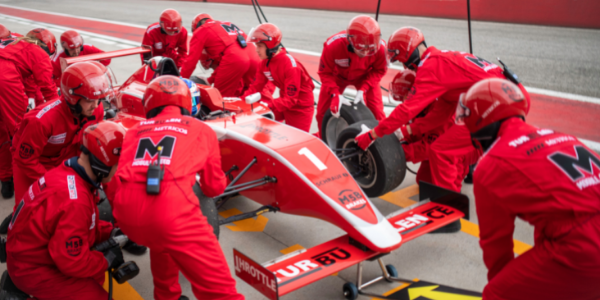
Why Every Project Needs A Formula One Style Pit Stop
As a bit of a motor head, I was excited to watch the inaugural Formula One sprint race format at the British Grand Prix recently. I was pondering Formula One and how efficiently the teams work to make sure that everything comes together so that teams can perform at their peak and achieve success in the ultimate test of speed. Thinking on it further, it occurred to me that there are lessons to be learned from Formula One pit stops that can be applied to project management, and specifically to project health checks. Here is why every project needs a Formula One style pit stop.
How Pit Stops are Like Project Health Checks
A Formula One pit stop occurs when the driver of the racing car pulls into “the pits”. The common activities that occur during a pit stop include replacing the tyres, repairs, and mechanical adjustments to the car to ensure that the vehicle is optimally placed to perform in the manner required of it. The driver’s helmet even gets cleaned to ensure the best vision for the rest of the race.
Projects, just like Formula One racing cars, need pit stops every so often to make sure the project is on track. A project health check can be likened very much to a Formula One pit stop. Both seek to ensure that success can be achieved through taking a brief interlude in the activities underway to check some of the key issues that might commonly arise. While a pit stop check changes the racing car tyres, a project health check examines the project indicators to make sure that nothing is going to let the team down.
Both activities can be undertaken efficiently to help steer the team towards success. There is no need to waste time with your pit stop (health check). The best teamwork ensures that the check is completed rapidly but efficiently, with everyone playing their part. The Red Bull team showed this with absolute perfection during the 2019 Brazilian Grand Prix in São Paulo Brazil when they beat the world record for pit stop speed in just 1.82 seconds! Now I am not suggesting your project health check is completed in 1.82 seconds… if you did that, you would risk negligence. But with sharp focus and everyone pulling their weight, the time spent on the health check can be optimized.
Let us think for a minute about what would happen if there was no pit stop. The car might very well continue to complete the race. But there would be every chance that the tyres would not be in great condition and would not be well placed to perform at the high standard expected of them, because of extreme wear. As with the Grand Prix, stopping to undertake a health check on your project can help ensure that it too has the best chance of performing at the highest possible level to achieve the goals required of it. That is why every project needs pit stops to ensure everything is on course for the win.
Advertisement
[widget id=”custom_html-68″]
What to Look for in a Project Health Check
With a project health check, you need to look out for signs that the team might not be performing optimally. There are several symptoms to consider. One of the key areas to consider is what the people are doing and how they are behaving. Research shows that people factors are a key factor in project failure (in a third of cases). Look at what the team is doing. Are they focused or distracted? Are they committed to the project vision, or are they seeking to advance their own agendas? This is important to address, otherwise, it may affect the likelihood of delivering the project on time and to budget or meeting the requirements of it.
Consider how people are communicating with one another, and how motivated they seem towards delivering the project. If they seem stressed, the health check is a suitable moment to ask yourself (and them!) why that is. Has the project scope crept? Are there sufficient resources assigned to different aspects of the project to enable people to meet the timelines required of them? Are processes working how they should, to drive project success? By taking a brief interlude to examine these areas, you can identify issues and get the project back on track, to avoid failure.
Steps to Take at a Project Health Check
One key step to take during a project health check is to reiterate the vision to ensure everyone clearly understands it and believes in it. Ask people questions to find out where they are at, not just with the activities they are carrying out, but how they feel about achieving the deadlines. You will also want to avoid further scope creep if that has occurred. Make sure the processes are in place and sufficiently robust to ensure that if movement to the scope is required, that the required resources are also put in place to help the team achieve the new tasks in the specified time frame. Do look at how people are communicating with one another and clear up any potential sources of confusion or distraction to make sure that people are completely focused on the tasks at hand.
Summary
Every team can benefit from a brief pit stop to make sure that it is working optimally to perform to the highest possible standard. A project health check can help you address people (and other) issues that might otherwise lead to project failure, fine-tuning the team to help it deliver the success that it is primed for. A health check is not a waste of time, rather, it is an essential activity to drive project success, to help ensure on-budget and on-time delivery.